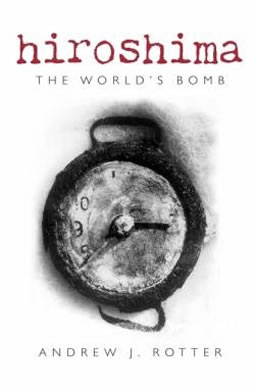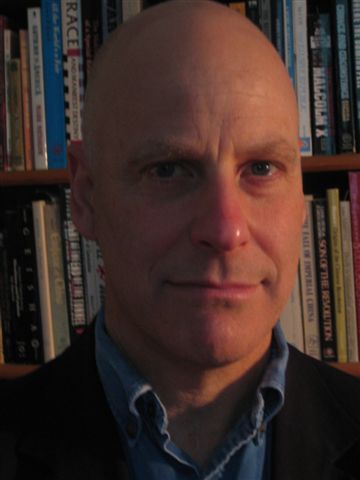This is yet another book about the nuclear bomb, its origin and the evolution of its use in war and in politics. It has no revolutionary revelations to offer, but it succeeds as a good overview of a number of themes about the motivations and policies related to the development of the bomb and its later use as a tool in the cold war.

"Hiroshima - The World's Bomb" -- -front
—*—
The general history of the famous Bomb and the Manhattan Project that created it, that history is fairly well-known. So why write yet another book on this topic? In this case, the author Andrew J. Rotter tries to broaden the perspective, arguing that we should not understand the Bomb as just a particular phenomenon that emerged within Project Manhattan, but that the Bomb is something that concerns all of the world. Hence the subtitle of the book — “The World’s Bomb“. Does Rotter deliver on his implicit promises? Yes, he does, but there are certain perspectives relevant to his aim that he surprisingly does not cover.
The Bomb
When we talk about the Bomb (with a capital B) we most often mean the first nuclear bomb that was exploded with intent to kill and destroy … the Hiroshima atomic bomb. A few days later, yet another bomb was dropped on Nagasaki, but that bomb, and its victims, have never received the kind of attention that was accorded to the Hiroshima bomb and the Hiroshiman victims. As is often said: winner takes all.
Since then, an enormous amounts of nuclear bombs have been produced, but they have so far only been used as threats, not used as weapons in some conflict. During the Cold War, the terror balance between the east and the west rested very much on the possibility of mutual annihilation using nuclear bombs. During that era, a significant part of the world was worried about the risk for a nuclear war. When the cold war ended, there was some relief, but nuclear powered explosive devices became a fresh cause for alarm: some smaller countries got the bomb (e.g., North Korea), or there was serious suspicions that they had embarked on a project to develop a bomb (e.g., Iran). And then there were these terrorist organisations that might get the idea to acquire a nuclear device of some sort.
Therefore, it may be reasonable to talk about it as “the world’s bomb”.
The Book
Rotter lays out the groundwork for his story by describing two other weapon technologies that in a sense brings moral issues to the front. The first is the use of gas in battle, which was heavily used in World War I. Sophisticated gases are treacherous, as they do not create a clear signal that something is going to happen (no smell), and that there may be no safe protection from it (gases can get in everywhere). Morally speaking, should gas be allowed as a weapon?
The second weapon technology is airborne bombing. It is difficult to distinguish military personnel from civilians when you are flying at a high altitude, so bombing from planes tends to be indiscriminate. There has in modern times been an understanding (and, to a certain extent, agreed upon through some international conventions) that civilians should not be harmed by military actions. Morally speaking, should we allow a weapon that makes it practically impossible to avoid harming civilians?
As Rotter argues, gas was only seriously used in WWI, but later never really deployed. Notable exceptions are: in some colonial military actions between the wars; during WWII, the US produced and transported mustard gas to Europe to be used in case the Germans started to use such weapons; By the Japanese during WWII; during the Iran-Iraq war in the 1980s; etc. Use of gas as a weapon was regulated trough international agreement in the Geneva Protocol of 1929, to some extent based on moral judgements, even though purely military reasons were the main underlying rationale.
But Rotter also reminds us that air bombing has become an ever more used method in various kinds of war and war-like situations. So there we cast moral judgements aside.
And this brings in one dimension in Rotter’s story about nuclear bombs: did the persons engaged in developing nuclear bombs think about ethical and moral issues regarding the effects this development was aiming at?
The book describes how scientists started to think about the possibility of a nuclear chain reaction that could release an enormous amount of energy. Scientists from several countries were familiar with the idea, and there was some international collaborations on related issues in the science of nuclear physics. The military got interested and involved, but initially in a hesitating way. Then the Manhattan project was started as a strategic US effort, enrolling scientists that originated from many different countries. The bomb was developed, and then the bombings Hiroshima and Nagasaki happened.
The moral issue
Rotter presents the science of physics as the common knowledge base upon which physics scientists created the applied science and technology that resulted in the bomb. One idealistic view of science is that science (and scientists) only has solidarity towards science itself and to the international community of scientists — “The Republic of Science”. According to that thinking, scientists should not engage in something that is of advantage to one country and disadvantage to another country. The progress of science itself — progress of pure science — is the collective effect of all international scientists. Real scientific progress critically depends on knowledge to be open, so scientists can build upon the results of other scientists. As Newton famously said: “If I have seen a little further it is by standing on the shoulders of Giants.”
Rotter gives a line of argument that most scientists adhered to the general idea of a “Republic of Science”, but the situation they were in (WWII, and possible risk that Germany could develop a nuclear fission bomb, which would place a unique weapon in the hands of the Nazi regime) made it morally permissible — perhaps even morally obligatory — to engage in a crash program to develop a bomb.
Some scientists were never fully convinced that such a weapon should be deployed. Other scientists thought that it should be used as an explicit threat to the enemy. Yet others thought that when it was finally available in a usable form, then this super weapon was no longer critically needed. And finally some thought that it should definitely be used, even if only as a demonstration of its cataclysmic effects.
The political rationale for dropping the bombs.
Ultimately it was a presidential decision that was the cause of the droppings of the bombs. There has been some debate about whether it was necessary to drop the bombs (and get the devastating effects on generations of Japanese subjected to nuclear fall-out). There are many lines of reasoning. One of the most convincing, practically speaking, is that this would save American soldiers from having to invade the Japanese mainland, which could entail a terrible cost in casualties. Another politically more subtle argument was that dropping these bombs should make the war end before the Soviet Union could invade core Japanese land, and thereby claim that the Soviet Union should be party of the peace-making process for Japan. USA wanted to have complete command and control of the Japanese surrender and terms and conditions for post-war Japan. The bomb would hopefully terminate the war so early that the Soviet union would be out of the picture.
Another motivation was to make a strong impression on the Soviet Union, so that they would be more willing to negotiate about post war international relations. As an effect of the strong Soviet performance in the last years of WWII, they regarded themselves as strong enough to dictate conditions to the other allied partners, at least in the context of eastern and central Europe. An American Bomb would make Stalin behave with some restraint in the negotiations.
Rotter also brings up another kind of argument, that is surprising, but also revealing about certain aspects of a democratic society. A reason that the White House understands is that if the bomb was not dropped (on Japan), the White House would have some potentially difficult explaining to do about the huge hidden funds used to finance the Manhattan Project. A Congressional investigation had come upon the funds that was used, and started to ask questions about the highly secret use of these funds. Not having anything concrete to show as the result of the huge amount of money spent could be devastating for the president. So better have some results to point to, and then a destroyed Japanese town would be a strong argument that would silence the political opponents.
Nuclear explosions
Even though only two atom bombs were used in actual warfare (the Hiroshima and Nagasaki bombs), more that 2000 nuclear bombs have been exploded by 8 countries — officially as testing of nuclear bombs.
A pedagogical visualisation of the time line of all these test explosions has been created by Isao Hashimoto. Watching it is both interesting and a bit scary. One can perhaps feel some comfort in the fact that we are not in these days seeing such intensive testing as was happening in the 1960s and 1970s. But we have seen that some countries have acquired nuclear explosive technology during the recent decades, so in a sense there are more heads of states that could make a decision to deploy a nuclear bomb against what is perceived as an enemy.
What is missing?
To present the story about “The World’s Bomb”, and not mention the popular anti-bomb movements, that is strange. One of the much publicized popular movements of the 1950s was the demonstrations, agitations, and debating about the danger of a “nuclear autumn”, which engaged a lot of citizens in Europe. An example is the Campaign for Nuclear Disarmament (1957 – ), where for instance Bertrand Russell was a widely known spokesperson for the anti-nuclear movement. This grass-root movement, and others like it, are not mentioned by Rotter.
Rotter does mention the Bulletin of the Atomic Scientists (1945 – ), but does not emphasize the role of the Bulletin (and of the group of scientists behind it) as a voice expressing the perils of uncontrolled proliferation of nuclear weapons. A core aim of the Bulletin was educational — to explicate the relationship between scientific and technical advances in the area and the politics concerning nuclear armaments.
The Pugwash Conferences on Science and World Affairs (1957 – ) is another effort that tried to raise public awareness about the arms race in general and nuclear weapons in particular.
So, in the context of the Bomb being a global concern, Rotter’s way of describing the grass-root efforts highlighting a fear of possible nuclear catastrophic scenarios, this is surprisingly more or less ignored.

Andrew J. Rotter

Andrew J. Rotter
The Author
Andrew J. Rotter is (2008) Charles A. Dana Professor of History at Colgate University. He specializes in US diplomatic history, recent US history, and the Vietnam War, and has written extensively on US-Asian relations during the twentieth century, including the books The Path to Vietnam and Comrades at Odds: India and the United States.
(from publisher’s author presentation)
More info at Rotter’s professional home page (at Colgate University)
Conclusion
Despite the way the author overlooks the public opinion concerning perils of nuclear weapons, the book is clear and thought-provoking. And well worth reading in these days where nuclear threats may originate in unexpected parts of the world.
Data
Andrew J. Rotter: “Hiroshima – The World’s Bomb” (Oxford University Press, 2008), 357 pages; ISBN 10: 0192804375; ISBN 13: 9780192804372 (book at openlibrary.org)
This page: https://whenthenightcomesfallingfromthesky.wordpress.com/2010/12/05/book-hiroshima-the-worlds-bomb-the-atomic-bomb-and-everbodys-concern/